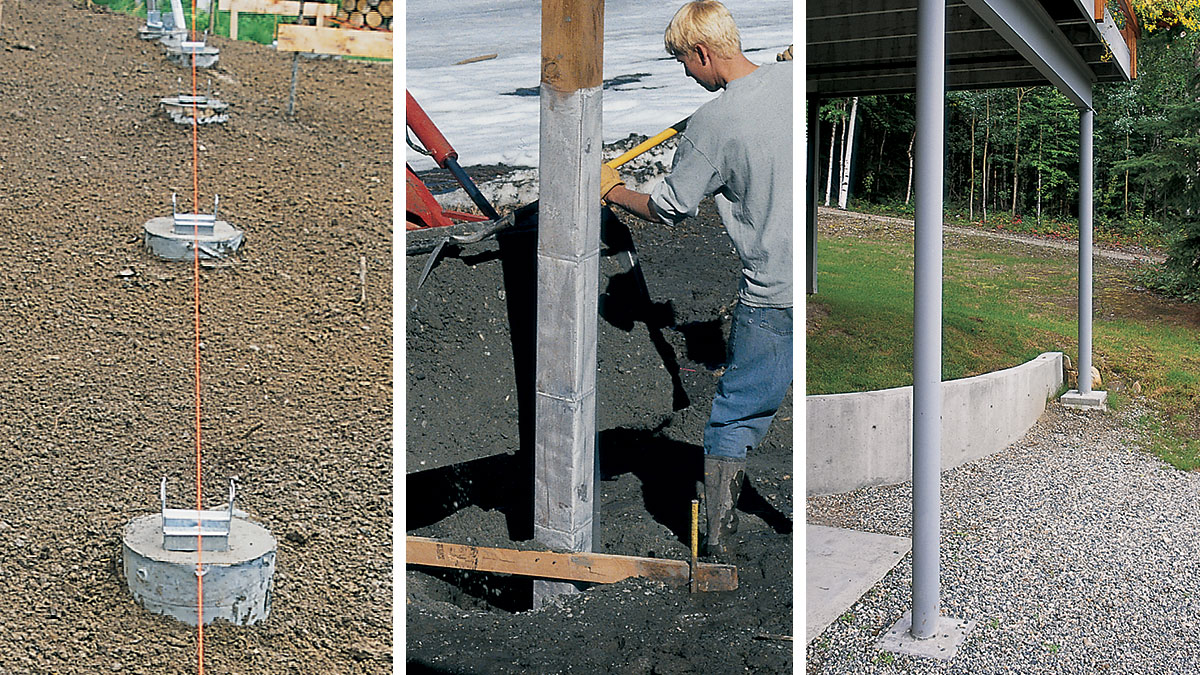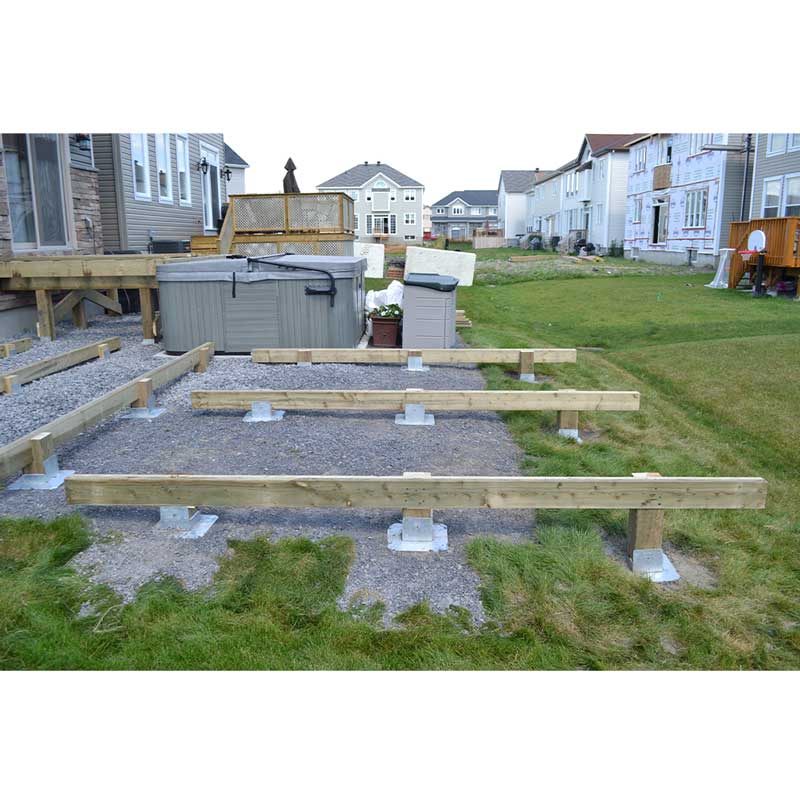Guarantee Security and Durability With Correctly Installed Deck Grounds
Deck footings might not be the most extravagant element of deck building, however they play an important role in ensuring security and long life. In this discussion, we will explore the relevance of appropriate deck footings, factors to take into consideration throughout setup, different types of grounds offered, step-by-step installation overview, and upkeep ideas for making sure lasting footings.

Significance of Correct Deck Grounds
Why are appropriately set up deck grounds vital for the security and long life of your deck? Deck grounds are the structure on which the deck relaxes, transferring the tons from the deck to the ground.
First of all, correctly set up deck footings distribute the weight of the deck evenly, avoiding any type of unequal settling or sinking. This is specifically vital in locations with unstable soil, as it helps to mitigate the risk of the deck changing or falling down. Additionally, well-installed footings ensure that the deck remains degree, protecting against any kind of architectural damages that can happen when a deck becomes uneven.
Secondly, effectively set up footings provide a strong support for the deck, protecting against too much motion and sway. This helps to maintain the architectural honesty of the deck, minimizing the danger of mishaps or injuries. It additionally decreases the deterioration on the deck, permitting it to endure the aspects and normal use for a longer duration of time.
Variables to Take Into Consideration for Deck Footing Setup
When setting up deck footings, there are several important elements to take into consideration for correct installation. Various dirt types have different load-bearing capacities, so it is crucial to perform a dirt test to guarantee the grounds can support the weight of the deck and its occupants. By taking right into account these aspects, you can make sure the proper installation of deck grounds and appreciate a steady and resilient deck.
Sorts Of Deck Footings to Select From
There are a number of different kinds of deck footings available for you to pick from. Each type has its very own advantages and negative aspects, so it's important to consider your certain needs and the problems of your deck before making a choice.
One common sort of deck ground is the concrete ground. This includes digging holes in the ground and putting concrete right into them to produce a solid structure. Concrete grounds are long lasting and supply outstanding stability, making them ideal for decks in locations with difficult soil problems or high wind tons.
Another option is the helical pier ground, which includes a steel shaft with helical plates that are screwed into the ground. These grounds fast to install and can be used in numerous soil types, consisting of sandy or clay soils. They are additionally flexible, enabling easy progressing of the deck.
Sonotube footings are another preferred option. These grounds are produced by placing a cardboard tube in an opening and filling it with concrete. Sonotube grounds are fairly easy to mount and offer adequate security for smaller decks or in locations with less requiring soil problems.
When choosing the kind of deck ground, it's crucial to consider factors such as soil problems, deck dimension and weight, neighborhood building ordinance, and individual choices. By choosing the suitable footing type, you can ensure the security and long life of your deck.
Step-by-Step Overview for Setting Up Deck Footings

Establish the location: Start by noting the exact setting of each ground using stakes and string (Deck Footings). Take right into account any regional building regulations or regulations relating to trouble distances
Dig the holes: Make use of a message opening miner or an auger to dig the openings for the footings. The depth will certainly rely on the frost line in your area and the sort of dirt. Usually, a deepness of at least 36 inches is suggested for security.
Degree the openings: Ensure that all-time lows of the openings are degree (Deck Footings). This can be attained by utilizing a level or a straight informative post board across the top of the holes
Add gravel: Location a layer of crushed rock at the base of each opening to improve drainage and stop the ground from sinking right into the dirt with time.
Put the ground kinds: Place the footing creates into the openings, ensuring they are centered and level. Use risks to safeguard them in position.
Mix and put concrete: Adhere to the directions on the concrete mix bag to prepare the concrete. Put the concrete right into the ground kinds, loading them entirely.
Smooth the surface area: Use a trowel to smooth the surface of the concrete and get rid of any kind of air pockets. Enable the concrete to treat according to the producer's guidelines.
Maintenance Tips for Durable Deck Grounds
Proper maintenance is important for making certain the longevity and stability of deck grounds. By routinely evaluating and maintaining your deck footings, you can stop damage and possible safety hazards. One crucial element of upkeep is to frequently check for any kind of indications of damage, such as fractures or activity in the footings. It is vital to address them immediately to stay clear of further damages. if you observe any concerns.
Regular cleaning is additionally essential for preserving deck footings. Greenery, dust, and debris can build up around the footings, which can bring about moisture buildup and decay. Cleansing the grounds frequently, making use of a pressure or a brush washer, can assist protect against these issues and extend the life expectancy of your deck.
In enhancement to cleansing, it is necessary to keep the area around the footings clear of any type of obstructions. Avoid stacking products against the footings or enabling plants to grow as well near to them. These blockages can catch dampness and create the grounds read this to wear away over time.
Lastly, routine resealing of the grounds is suggested to secure them from wetness and various other environmental aspects. Applying a water resistant sealant can assist avoid water damage and extend the lifespan of the footings.
Conclusion
In final thought, appropriate setup of deck footings is essential for making sure stability and longevity of your deck. Factors such as dirt kind, tons capability, and regional building codes require to be taken into consideration when choosing the right kind of deck grounds. Complying with a step-by-step overview for installment and routine maintenance will aid to make sure the footings remain sturdy and resilient.
In this discussion, we will certainly check out the importance of correct deck footings, factors to take into consideration during installation, various types of grounds offered, detailed installation overview, and maintenance tips for making certain lasting grounds. Deck footings are the structure on which the deck rests, moving the tons from the deck to the ground.One common type of deck ground is the concrete footing. Put the ground forms: Put the footing creates into the openings, guaranteeing they are centered and degree.In final thought, correct installation of deck grounds is essential for making certain stability and long life of your deck.